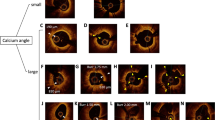Abstract
Cutting balloons and scoring balloons are commonly used for the preparation of calcified lesion. However, problems with crossability occasionally limit the use of cutting balloons. We prospectively selected 173 calcified lesions treated using a novel cutting balloon (Wolverine™, C group). As control, we retrospectively analyzed 146 calcified lesions treated using a scoring balloon (Lacrosse NSE ALPHA™, S group). Either intravascular ultrasound (IVUS) or optical coherence tomography (OCT) was used by the operator’s discretion. The primary outcome was delivery success, which was defined as successful passage to the target lesion immediately after IVUS or OCT evaluation. The secondary outcome was acute cross-sectional area (CSA) gain, which was defined as post-interventional minimum stent area minus pre-procedural minimum lumen area. A multivariate analysis evaluated the independent predictors for delivery success. The delivery success rate was significantly higher in the C group versus the S group (90.8% versus 79.5%, P = 0.006). However, the acute CSA gain was similar between the two groups (IVUS: 3.2 ± 1.8 mm2 versus 3.4 ± 1.9 mm2, P = 0.53; OCT: 3.6 ± 1.4 mm2 versus 4.1 ± 1.9 mm2, P = 0.11). Usage of cutting balloon was an independent predictor for delivery success even after the adjustment for the patient and lesion characteristics [odds ratio (OR): 2.72 (95% confidence interval 1.38–5.33), P = 0.004] as well as the procedural characteristics [OR: 2.34 (1.15–4.86), P = 0.018]. Novel cutting balloons demonstrated better crossability and similar acute CSA gain compared with scoring balloons in calcified lesion.


Similar content being viewed by others
References
Moses JW, Leon MB, Popma JJ, Fitzgerald PJ, Holmes DR, O'Shaughnessy C, et al. Sirolimus-eluting stents versus standard stents in patients with stenosis in a native coronary artery. N Engl J Med. 2003;349:1315–23.
Sonoda S, Morino Y, Ako J, Terashima M, Hassan AH, Bonneau HN, et al. Impact of final stent dimensions on long-term results following sirolimus-eluting stent implantation: serial intravascular ultrasound analysis from the sirius trial. J Am Coll Cardiol. 2004;43:1959–63.
Doi H, Maehara A, Mintz GS, Yu A, Wang H, Mandinov L, et al. Impact of post-intervention minimal stent area on 9-month follow-up patency of paclitaxel-eluting stents: an integrated intravascular ultrasound analysis from the TAXUS IV, V, and VI and TAXUS ATLAS Workhorse, Long Lesion, and Direct Stent Trials. J Am Coll Cardiol Intv. 2009;2:1269–75.
Haase J, Escaned J, van Swijndregt EM, Ozaki Y, Gronenschild E, Slager CJ, et al. Experimental validation of geometric and densitometric coronary measurements on the new generation Cardiovascular Angiography Analysis System (CAAS II). Cathet Cardiovasc Diagn. 1993;30:104–14.
Mintz GS, Nissen SE, Anderson WD, Bailey SR, Erbel R, Fitzgerald PJ, et al. American College of Cardiology clinical expert consensus document on standards for acquisition, measurement and reporting of intravascular ultrasound studies (IVUS): a report of the American College of Cardiology Task Force on Clinical Expert Consensus Documents. J Am Coll Cardiol. 2001;37:1478–92.
Kotani J, Mintz GS, Castagna MT, Pinnow E, Berzingi CO, Bui AB, et al. Intravascular ultrasound analysis of infarct-related and non-infarct-related arteries in patients who presented with an acute myocardial infarction. Circulation. 2003;107:2889–933.
Tearney GJ, Regar E, Akasaka T, Adriaenssens T, Barlis P, Bezerra HG, et al. Consensus standards for acquisition, measurement, and reporting of intravascular optical coherence tomography studies: a report from the International Working Group for Intravascular Optical Coherence Tomography Standardization and Validation. J Am Coll Cardiol. 2012;59:1058–72.
Amemiya K, Yamamoto MH, Maehara A, Oyama Y, Igawa W, Ono M, et al. Effect of cutting balloon after rotational atherectomy in severely calcified coronary artery lesions as assessed by optical coherence tomography. Catheter Cardiovasc Interv. 2019. https://doi.org/10.1002/ccd.28278.
Ashida K, Hayase T, Shinmura T. Efficacy of lacrosse NSE using the "leopard-crawl" technique on severely calcified lesions. Invasive Cardiol. 2013;25:555–64.
Jujo K, Saito K, Ishida I, Kim A, Suzuki Y, Furuki Y, et al. Intimal disruption affects drug-eluting cobalt-chromium stent expansion: a randomized trial comparing scoring and conventional balloon predilation. Int J Cardiol. 2016;221:23–31.
Miyazaki T, Latib A, Ruparelia N, Kawamoto H, Sato K, Figini F, et al. The use of a scoring balloon for optimal lesion preparation prior to bioresorbable scaffold implantation: a comparison with conventional balloon predilatation. EuroIntervention. 2016;11:e1580–e15881588.
Matsukawa R, Kozai T, Tokutome M, Nakashima R, Nishimura R, Matsumoto S, et al. Plaque modification using a cutting balloon is more effective for stenting of heavily calcified lesion than other scoring balloons. Cardiovasc Interv Ther. 2019;34:325–34.
Acknowledgements
We wish to thank Mr. Hiroki Oyama, Mr. Kazutoshi Ito and Mr. Yusuke Katagiri for their expertise in performing the IVUS and OCT examinations and Ms. Saori Kashu for her expertise in the collection of data.
Funding
None.
Author information
Authors and Affiliations
Corresponding author
Ethics declarations
Conflict of interest
Osamu Iida has a remuneration from Boston scientific Japan. The remaining authors have no disclosures to report.
Additional information
Publisher's Note
Springer Nature remains neutral with regard to jurisdictional claims in published maps and institutional affiliations.
Rights and permissions
About this article
Cite this article
Ishihara, T., Iida, O., Takahara, M. et al. Improved crossability with novel cutting balloon versus scoring balloon in the treatment of calcified lesion. Cardiovasc Interv and Ther 36, 198–207 (2021). https://doi.org/10.1007/s12928-020-00663-5
Received:
Accepted:
Published:
Issue Date:
DOI: https://doi.org/10.1007/s12928-020-00663-5




